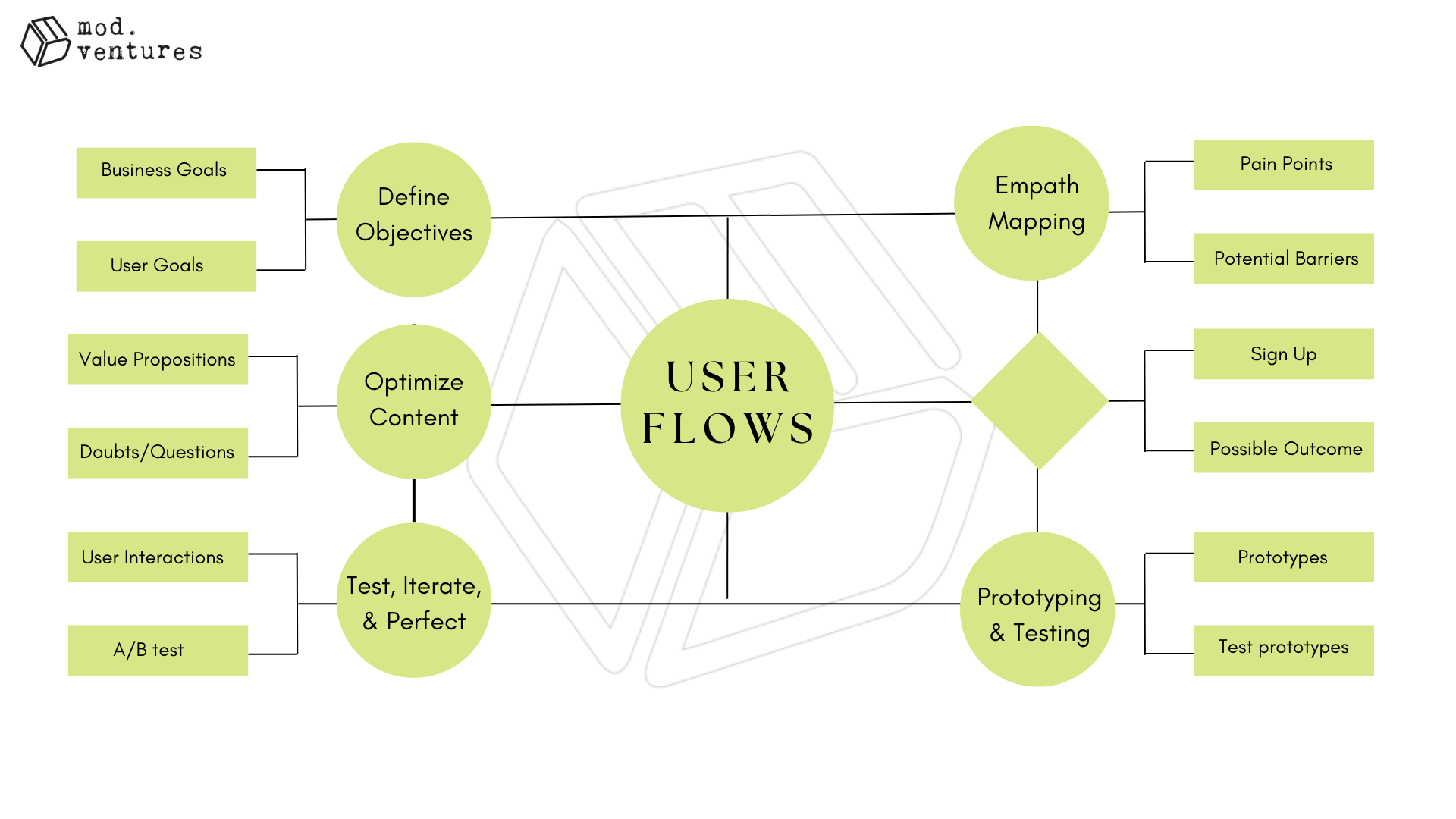Unlocking the Power of User Flow to Drive Conversions

A user flow or user journey mapping represents the path visitors take on your app or website to accomplish a specific goal, whether booking a reservation, making a purchase, or signing up for a service. A thoughtfully designed user flow optimization doesn’t just guide users—it builds trust, reduces friction, and maximizes conversion rate optimization. You can significantly boost engagement and conversions by aligning your UX design and digital product design with your business objectives and user needs.
The Wrong Way to Approach App and Website Design
Many apps and websites struggle because they overlook the fundamentals of user experience (UX) and UI/UX best practices.
Consider these flawed approaches:
- Scenario A: Revamping the visuals without addressing functionality, website user flow, or the customer journey.
- Scenario B: Starting from scratch with basic building blocks yet lacking a cohesive UX strategy.
Both scenarios fail to prioritize the customer journey, resulting in poor engagement and subpar conversion optimization. The key is integrating user flow analysis at every stage of the design process.
6 Steps to Crafting a Winning User Flow
1. Define Objectives for Both Your Business and Users
Begin by clarifying:
- Your Goals: What actions do you want users to take? (e.g., make a purchase, sign up, subscribe)
- User Goals: What problems are they solving or needs are they aiming to fulfill?
Aligning these objectives sets a solid foundation for UX design and conversion rate optimization.
2. Empathy Mapping: Understand Your Audience
Delve into your users’ motivations, emotions, and pain points. Tools like empathy maps help you visualize:
- What users think, feel, and do while engaging with your platform.
- Potential barriers that might hinder user engagement or cause drop-offs in your customer journey.
This process is crucial for designing a user flow that truly meets user needs.
3. Map Out the Flow with Decision Diamonds
A decision diamond represents crucial moments in the user journey where choices are made, such as:
- “Do I sign up now or browse more?”
- “Do I add this item to my cart or look at alternatives?”
Mapping these decision points helps identify potential bottlenecks, ensuring a smoother website user flow and enhanced conversion optimization.
4. Prototyping and Testing
Before launching your digital product, create prototypes of your app or website. Prototyping allows you to:
- Visualize the user flow and overall UX design.
- Test early iterations with real users using A/B testing and other feedback tools.
- Refine your design to optimize the customer journey and boost conversion rates.
5. Optimize Content and Calls to Action (CTAs)
Effective digital product design means providing the right content at the right time:
- Highlight clear value propositions.
- Include testimonials or case studies to build trust.
- Use seamless CTAs (e.g., “Start Your Free Trial”) to drive conversion rate optimization.
- Address user doubts to encourage action.
6. Test, Iterate, and Perfect
No user flow optimization is perfect on the first try. Use the following methods for continuous improvement:
- Analytics: Identify where users drop off or experience friction.
- A/B Testing: Experiment with variations to see which design elements perform best.
- User Testing: Observe real users as they navigate your platform to find areas for enhancement.
Designing for “Flow”
User flow is about more than navigation—it’s about creating a seamless user experience (UX) that keeps users engaged and moving toward conversion. Drawing from the psychology of “flow,” consider these principles:
- Set clear goals and paths: Define the intended customer journey.
- Provide immediate feedback: Use prompts like “Item added to cart” to confirm actions.
- Minimize delays: Eliminate repetitive tasks that slow down the experience.
- Offer discovery opportunities: Keep users curious with engaging features.
- Avoid disruptions: Steer clear of cluttered interfaces and unclear navigation.
Examples of Great User Flow
- Tastebuds: A music-focused platform with a seamless mobile app development experience that guides users from discovery to interaction.
- Codecademy: An excellent example of digital product design that offers structured learning paths, clear objectives, and immediate feedback.
A Case Study: Crafting a User Flow for a Personalized Fitness App
Imagine designing an app and website for a company offering tailored fitness plans. The business goal is to drive online subscriptions through optimized user flow. Here’s how the process unfolds:
- Empathy Mapping: Interview potential users to understand their goals, motivations, and pain points. Identify why they might subscribe and what concerns them.
- Traffic Analysis: Tailor user flows for different traffic sources, such as organic search, paid ads, or social media.
- Decision Diamonds: Map out key decision points, like “Do I need a free trial first?” or “Is this plan customizable enough for me?”
- Prototyping and Testing: Develop wireframes to simulate the journey, gather user feedback, and refine the UX design.
- Optimize for Trust: Emphasize features like expert-designed plans, flexibility, and success stories to address user doubts and boost conversion optimization.
Conclusion
A well-crafted user flow bridges the gap between your business goals and your users’ needs. By understanding user motivations, prototyping solutions, and iterating based on feedback, you can create a seamless digital experience that drives conversions and builds loyalty. Whether you’re in MVP development or mobile app development, or need a comprehensive software development strategy, integrating effective user flow optimization is key.
Ready to optimize your app and website’s user flow?
Schedule a free consultation call today or fill out our form to learn more about our custom software solutions and how we can help drive your conversion rate optimization.
